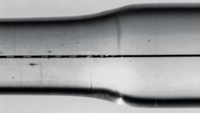Advertisement
Grab your lab coat. Let's get started
Welcome!
Welcome!
Create an account below to get 6 C&EN articles per month, receive newsletters and more - all free.
It seems this is your first time logging in online. Please enter the following information to continue.
As an ACS member you automatically get access to this site. All we need is few more details to create your reading experience.
Not you? Sign in with a different account.
Not you? Sign in with a different account.
ERROR 1
ERROR 1
ERROR 2
ERROR 2
ERROR 2
ERROR 2
ERROR 2
Password and Confirm password must match.
If you have an ACS member number, please enter it here so we can link this account to your membership. (optional)
ERROR 2
ACS values your privacy. By submitting your information, you are gaining access to C&EN and subscribing to our weekly newsletter. We use the information you provide to make your reading experience better, and we will never sell your data to third party members.
Materials
Giving Strength to Glass
Sea sponge overcomes inherent weakness with clever construction
by Bethany Halford
July 11, 2005
| A version of this story appeared in
Volume 83, Issue 28
MATERIALS ENGINEERING

The lattice of thin glassy threads that makes up the glass sea sponge Euplectella's skeleton doesn't seem like it would stand up to the stress and strain of the deep ocean. But the sponges' glass skeletal cages are actually so strong that breeding pairs of shrimp live within their walls. According to a new report, this remarkable resilience comes from a structure that's ingeniously engineered at every scale (Science 2005, 309, 275).
A research team led by Joanna Aizenberg, a materials scientist at Lucent Technologies' Bell Labs in Murray Hill, N.J., finds that, at every level in its structural hierarchy, the glass sea sponge had evolved a way to overcome the brittleness of its building materials. "Nature has found a way to perfect inherently fragile materials by employing standard engineering principles from the nano- to the macroscale," Aizenberg says.
At nanoscale lengths, the researchers find, Euplectella's skeleton is made up of silica nanospheres arranged around a protein filament. At the next level in the hierarchy, the nanospheres form needlelike spicules out of dozens of concentric layers of silica. Alternating layers of organic material separate the silica layers as they decrease in thickness from around 1.5 m at the center to approximately 0.2 m at the periphery.
Aizenberg and coworkers attribute the glass's resilience to this lamellar structure. They contend that any damage to the spicules would be confined to the outer layers and that the organic material seems to prevent cracking.

At the next length scale, the spicules are joined into larger parallel bundles--a construction motif common in ceramic materials, the researchers point out. These bundled spicules are arranged horizontally and vertically to form a grid of glassy threads. Ancillary spicule fibers run diagonally through this grid, providing reinforcement to the structure.
The researchers note that this architecture resembles a number of monumental engineering wonders, such as the Eiffel Tower in Paris, the Swiss Re Tower in London, and the Hotel Arts Barcelona. "This creature's skeleton is a textbook lesson in mechanical engineering, offering valuable knowledge that could lead to new concepts in materials science and engineering design," Aizenberg says.





Join the conversation
Contact the reporter
Submit a Letter to the Editor for publication
Engage with us on Twitter